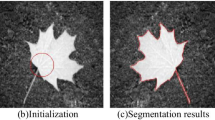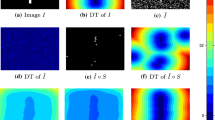Abstract
Coordinate descent, also known as iterated conditional mode (ICM) algorithm, is a simple approach for minimizing the energy defined by a Markov random field. Unfortunately, the ICM is very sensitive to the initial values and usually only finds a poor local minimum of the energy. A few modifications of the ICM algorithm are discussed here that ensure a more ‘gentle’ descent during the first iterations of the algorithm and that lead to substantial performance improvements. It is demonstrated that the modified ICM can be competitive to other optimization algorithms on a set of vision problems such as stereo depth estimation, image segmentation, image denoising and inpainting.








Similar content being viewed by others
References
Alahari, K., Kohli, P., Torr, P.: Reduce, reuse & recycle: Efficiently solving multi-label MRFs. In: CVPR (2008)
Barnard, S.: Stochastic stereo matching over scale. Int. J. Comput. Vis. 3(1), 17–32 (1989)
Besag, J.: On the statistical analysis of dirty pictures. J. R. Stat. Soc. Ser. B 48(3), 259–302 (1986)
Birchfield, S., Tomasi, C.: A pixel dissimilarity measure that is insensitive to image sampling. IEEE Trans Pattern Anal Mach Intell 20(4):401–406 (1998)
Bishop, C.: Pattern recognition and machine learning. Springer, Berlin (2006)
Boykov, Y., Veksler, O., Zabih, R.: (2001) Fast approximate energy minimization via graph cuts. IEEE Trans Pattern Anal Mach Intell 23(11):1222–1239
Chou, P., Brown, C.: The theory and practice of Bayesian image labeling. Int J Comput Vision 4:185–210 (1990)
Fletcher, R.: (2000) Practical methods of optimization. Wiley, New York
Guan, Y., Chen, W., Liang, X., Ding, Z., Peng, Q.: Easy matting: a stroke based approach for continuous image matting. J Comput Graphics Forum 25(3):567–576 (2006)
Kolmogorov, V.: Convergent tree-reweighted message passing for energy minimization. IEEE Trans Pattern Anal Mach Intell 28(10):1568–1583 (2006)
Komodakis, N., Tziritas, G., Paragios, N.: Performance vs computational efficiency for optimizing single and dynamic MRFs: setting the state of the art with primal dual strategies. Comput Vision Image Underst 112(1):14–29 (2008)
Komodakis, N., Tziritas, G.: Image completion using efficient Belief Propagation via priority scheduling and dynamic pruning. IEEE Trans Image Process 16(11):2649–2661 (2007)
Li, S.: Markov Random Field Modeling in Computer Vision. Springer, Berlin (1995)
Felzenszwalb, P.F., Huttenlocher, D.: Efficient belief propagation for early vision. Int J Comput Vision 70(1):41–54 (2006)
Ogawara, K.: Approximate belief propagation by hierarchical averaging of outgoing messages. In: ICPR (2010)
Rother C., Kolmogorov V., Blake A.: “‘GrabCut”’-interactive foreground extraction using iterated graph cuts. ACM Trans Graphics 23(3):309–314 (2004)
Rother, C., Kolmogorov, V., Lempitsky, V., Szummer, M.: Optimizing binary MRFs via extended roof duality. In: CVPR (2007)
Szeliski, R., Zabih, R., Scharstein, D., Veksler, O., Kolmogorov, V., Agarwala, A., Tappen, M., Rother C.: A comparative study of energy minimization methods for Markov random fields with smoothness-based priors. IEEE Trans Pattern Anal Mach Intell 30(6):1068–1080 (2008)
Yang, Q., Wang, L., Ahuja, N.: A Constant-Space Belief Propagation Algorithm for Stereo Matching. In: CVPR (2010)
Yedidia, J., Freeman, W., Weiss, Y.: Generalized Belief Propagation. In: NIPS (2000)
Author information
Authors and Affiliations
Corresponding author
Rights and permissions
About this article
Cite this article
Zivkovic, Z. Gentle ICM energy minimization for Markov random fields with smoothness-based priors. J Real-Time Image Proc 11, 235–246 (2016). https://doi.org/10.1007/s11554-012-0308-z
Received:
Accepted:
Published:
Issue Date:
DOI: https://doi.org/10.1007/s11554-012-0308-z




